Eurofins Agroscience Services are experienced in honey bee (Apis mellifera L.) tailor made field studies
We are experienced in honey bee (Apis mellifera L.) tailor made field studies. In these studies honeybees are exposed to the test item via a treated crop during flowering. The exposure time can be adapted to the questions that need to be addressed. Overwintering can also be included in order to cover a whole bee keeper year. We have extensive experience in the sampling and analysis of all bee matrices.
Honey Bee -Field Tests – EPPO 170, EFSA Guideline
For the evaluation of side effects of plant protection products (PPPs) on the honey bee (Apis mellifera L.) the study design can be adapted to the special nurture of a wide range of crops such as e.g. maize, citrus, melon, peach, strawberries, sunflower, apple, potato, rice, sugar beet, buckwheat, coffee, soybean and cotton. The experience was gained by our staff through working in different European countries as well as in Brazil, USA and China. This experience is a valuable tool in the adaptation of the study design to optimise results.
We have experience with a wide range of application technology as large scale spray application, seeding of coated seeds, application of abrasive dust with a self developed dust applicator.
During a field study, several parameters such as flight activity in the crop, behaviour, mortality of the bees in the crop (linen sheets), and in front of the hives (dead bee traps), and the conditions of the colonies and brood development are recorded before and after application. In addition to general parameters, we offer detailed observation on behaviour (e.g. homing behaviour), long-term observation of the bee colonies including over-wintering success, health assessment (virus and disease analysis at relevant time points) and residue samplings on all kinds of matrices of the bee hive and the crop.
In accordance with current OEPP/EPPO Guideline No. 170 and EFSA Guidance document, fields of at least 2 ha are used for field studies. Several replicates of field pairs are possible. In each field, six to eight commercial bee hives are installed for further assessments on bee mortality, flight intensity in the crop and behaviour of the bees in front of the hives and crop area. The condition of the colonies as well as the brood development is recorded once before and frequently over at least one month after treatment.
Further, effects of guttation can be assessed (observation of bees collecting guttation droplets from emerged plants before flowering in the field) and collection of guttation droplets for residue analysis. We have developed a study design for this kind of studies.
Sampling for Residue Analysis and Additional Information
The following samplings can be included:
- Sampling of forager bees in front of the hives
- Preparation of pollen loads and nectar stomachs from collected forager bees
- Sampling of bee products from within the hive: (nectar/honey, pollen, larval food, wax and royal jelly)
- Sampling of pollen from pollen traps (for residue analysis and / or pollen source identification)
- Sampling of plants and flowers
- Soil sampling for residue analysis
- Sampling of honey and bees from the hive for analysis of bee diseases and viruses in specialized laboratories
- Further samplings on special request
Industry partnerships
- LAVES Institut für Bienenkunde, Celle
- ai. (beecounter)
- Länderinstitut für Bienenkunde, Hohen-Neuendorf
- Long-term cooperation with local farmers
Participations, Memberships
- AG Bienenschutz
- ICPPR working groups
- International ringtest groups to work on OECD guideline proposals















